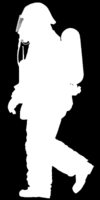Storyboard Artwork Project/Creating Tux Paint Stamps
|
How to create Tux Paint stamps for the Storyboard Artwork Project
 What are stamps in Tux Paint?
|
|
A Great Moment In History: The almost true story of "Alpha"
Here is the scientific logic behind the fourth image in a PNG picture. Each pixel of a PNG picture (a color picture for the computer) is described by 8 binary bits of red, 8 binary bits of blue and 8 binary bits of green. Since 32 binary bits is a very convienent word size for most computers (i.e., 4 times 8 binary bits), scientists said, "Let's use all 32 bits for a single pixel since this is very efficient. And in the 8 bits that are not being used, let's add a gray image which explains how transparent the RGB image is." Everyone agreed that this was a wonderful idea. But then someone said, "But what should we call this gray image since it is neither "red" nor "blue" nor "green"? We need a fancier name than "transparency" because that would be too simple. One scientist, whose name was "Fred" said he wanted to call it "Fred". Then another wanted to call it "Burt" Then another wanted to call it "Kate" and finally one wanted to call it "Christine" for the famous rocket scientist, Christine Latter of Boise, Idaho. Sadly, being scientists, they could not agree. So finally they simply called it by the totally ridiculous name of "Alpha" since that was the first letter of the Geek alphabet and, therefore, the only name they could agree on. And at the same time, they also decided that saying "red image" and "blue image" and "Alpha image" was not digified enough. So they decided to call the images "Channels" which sounds more scientific. (They did not want anyone to confuse them for English majors.) |
|
Index
 The lessons in the Storyboard Artwork Project
The completed rubber stamps for Tux Paint
Contact the project co-ordinator
|







